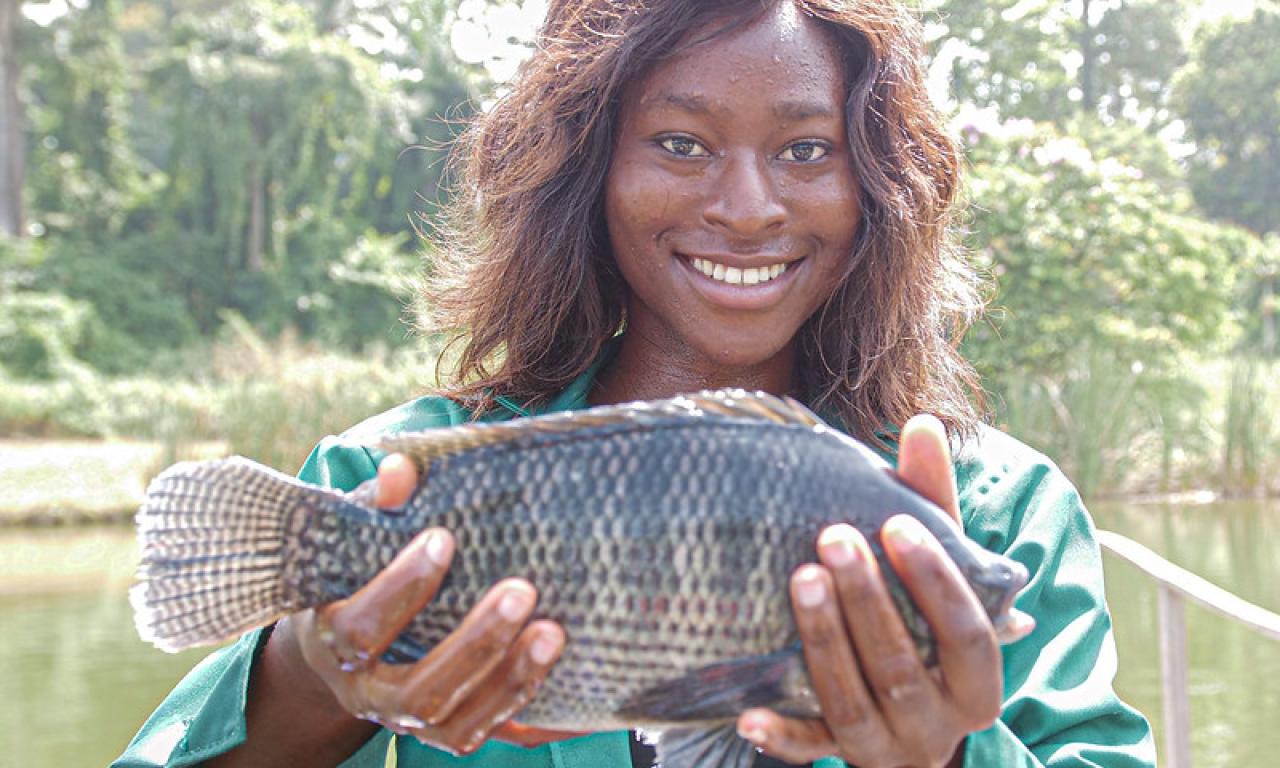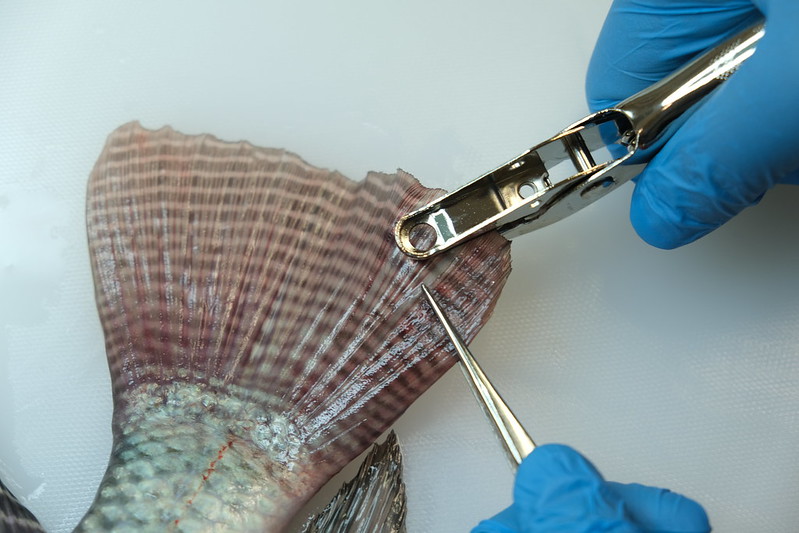
- For many years, the main trait for tilapia strain selection has been faster growth using traditional breeding approaches through quantitative genetics theory.
- However, emerging threats and challenges to the sustainability of small-scale and commercial Nile tilapia production have prompted WorldFish to go back to the drawing board.
- Future generations of GIFT will be enhanced to make them TiLV-resistant, with greater feed conversion efficiency as well as better growth under low oxygen conditions that will help supply chain actors produce sufficient and nutritious aquatic foods for healthier people and the planet.
Nile tilapia is one of the major aquaculture species in the world, eclipsed only by grass carp and silver carp. According to the latest FAO estimates, a total of 4.4 million tons of Nile tilapia is produced globally, accounting for 9% of the total production of major aquaculture species.
One of the contributors to the success of this species today is the development of the Genetically Improved Farmed Tilapia (GIFT) strain back in 1988. At the time, tilapia farming was plagued with numerous issues including poor productivity, deteriorating performance and inadequate supply of seed.
To address these issues, WorldFish, then known as the International Center for Living Aquatic Resources Management or ICLARM, worked with partners from the Philippines and Norway to produce a faster-growing strain of Nile tilapia that is suitable for aquaculture, both small-scale and commercial.
Pioneering a systemic breeding method
In collaboration with partners, WorldFish pioneered a systematic breeding method based on selective breeding programs for salmon and trout established in Norway in the 1970s.

Full sibling families – brother and sister seed from the same parents – are bred and then grown in separate cloth net cages until they are big enough to be individually tagged with Passive Integrated Transponders (PIT tags). They will then be transferred to a communal pond to be grown with seeds from other parents. The performance of all fish within the communal pond is monitored individually and fish from the best-performing families were then selected as parents of the next GIFT generation.
WorldFish has demonstrated that selective breeding is a feasible, cost-effective and sustainable approach to the genetic improvement of tilapia. The GIFT strain is a result of 28 years of selective breeding across 23 generations. It is being used in 17 countries around the globe.
An Asian Development Bank study found that GIFT and GIFT-derived strains accounted for 68%, 46% and 17% of tilapia production in the Philippines, Thailand and Vietnam, respectively. A survey conducted in Bangladesh found that 75% of hatcheries producing mono-sex tilapia were using GIFT broodstock.
Improving the livelihoods of aquatic food producers
The faster growth of the GIFT strain allows for a shorter production cycle and increased yield for the same plot of land, leading to reduced costs and increased profit. A more resilient strain will allow GIFT to be farmed in more environments, including those that are currently not feasible and reduces the risks of diseases.
In a recent on-farm performance assessment study with a stratified random sample of 213 GIFT and 256 non-GIFT producers in Bangladesh, it was found that the GIFT strain grew 27% and 29% faster than non-GIFT tilapia in monoculture and polyculture settings, respectively. GIFT yields were significantly higher than non-GIFT yields and GIFT species were more profitable and cost-effective than non-GIFT species.
As it has done for over three decades, GIFT continues to benefit aquatic food producers worldwide with its faster growth and continues to be in higher demand than ever. Accessibility to adequate quantities of faster-growing Nile tilapia during opportune seasons is imperative to ensure that the sector continues to grow.
Earlier this year, WorldFish partnered with Premium Aquaculture Limited for the transfer of GIFT fingerlings to and the establishment of a GIFT-based aquaculture industry in Nigeria with the aim of having GIFT tilapia in Nigerian fish markets by late 2023.
Harnessing the potential of GIFT in a changing climate
Higher growth rates and shorter production cycles also allow GIFT to be grown in seasonal ponds located in drought-prone and fish-deficit areas. This means that GIFT has a prominent role in how aquatic food producers adapt to a changing climate as it can increase animal protein yield per drop of water used.
Traits, such as resilience to unfavorable farming environments and disease resistance, have become increasingly important with global warming disrupting global food systems. GIFT can withstand these challenges in itself, but not without reliable hatcheries acting as broodstock dissemination centers and mass seed producers for aquatic food producers.
Meeting the needs of hatchery operators
High seed production per female, vigor of seed produced and fast growth rate of the seed until they reach marketable fingerling size are among the important traits hatcheries look for in broodstock, depending on the location and type of production systems.
The GIFT females have demonstrated the same fertility – number of eggs per female – compared to non-selected Nile tilapia females. GIFT’s superior growth also means broodstock consumes less feed. Improved feed efficiency helps reduce feed cost, the largest cost component in tilapia farming.
Coupled with GIFT’s ability to produce more vigorous fry, this will translate to better revenue and a shorter turnaround time. Faster-growing fry shortens the nursing period up to marketable sizes, reducing the risk of mortality in this highly vulnerable stage in which survival rate is of major concern to hatchery operators.
WorldFish continues to identify new challenges to provide holistic and innovative solutions in making aquatic food systems more resilient and sustainable for a food-secure future, particularly in a changing climate.
Pivoting to face new challenges
For many years, the main trait for selection has been faster growth using traditional breeding approaches through quantitative genetics theory. Emerging threats and challenges to the sustainability of Nile tilapia production have prompted WorldFish to go back to the drawing board to find innovative solutions to these problems.
The tilapia lake virus (TiLV) is not only causing fish losses but has necessitated the whole tilapia industry to rethink how fish are to be transported and the biosecurity of hatcheries including the breeding nucleus. Resilience in low oxygen conditions is also increasingly important as most small-scale farms do not employ mechanical aeration.
Future generations of GIFT will be enhanced in light of these findings to make them faster growing and TiLV-resistant. Using DNA-based methods and genomic tools, WorldFish is also developing protocols for the selection of seed that has greater feed conversion efficiency as well as better growth under low oxygen conditions that will help supply chain actors produce sufficient and nutritious aquatic foods for healthier people and the planet.
###
This article authored by Trong Trinh and John Benzie was originally published in the ISSUU: Hatchery Feed & Management.
